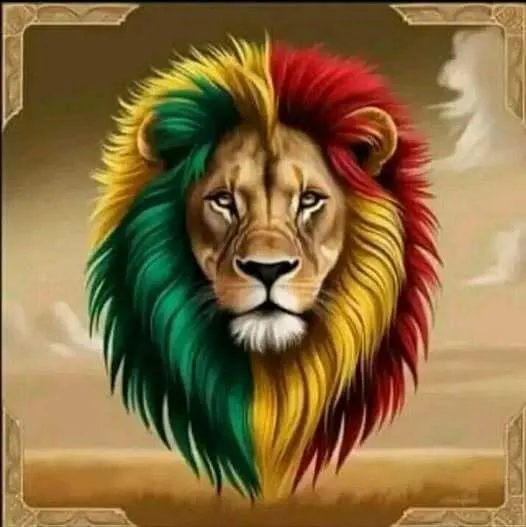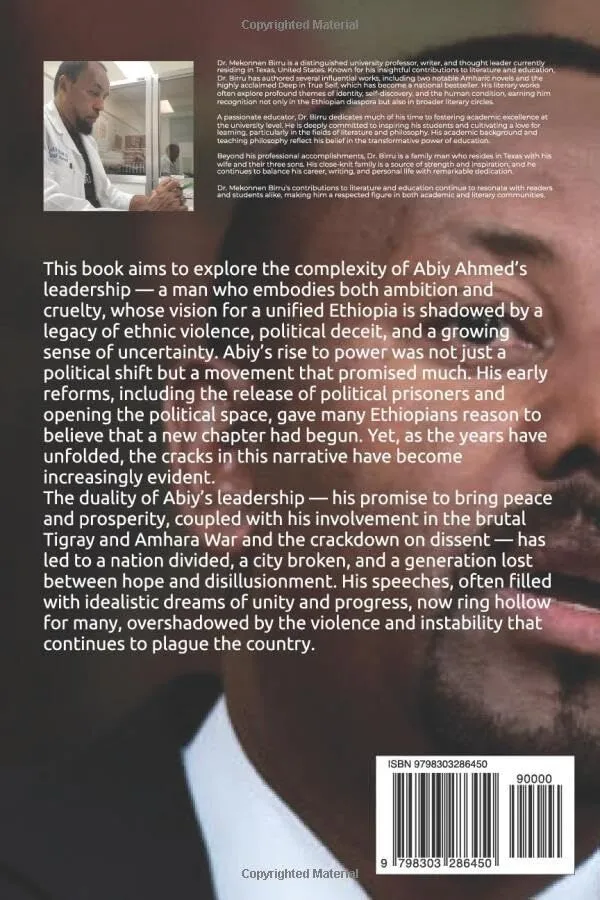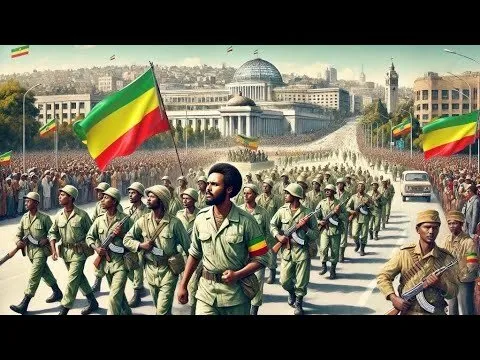Fayyis Oromia
The ongoing #OromoProtest for the last four months clearly showed us the exisitng very deep mistrust between the Ethiopian lovers and the Oromian promoters. Oromians are paying huge sacrifice of their life, while pro-Ethiopia opposition groups are endlessly discussing about the motive of the movement and who are behind it, instead of joining the protest and galvanizing the freedom struggle. The main fear of the Ethiopianists seem to be about the possible civil war between the Oromo and others as well as about the eventual disintegration of the empire. Even the pro-Ethiopia rhetoric of the unionist Oromo in the ODF and OFC couldn’t help in convincing the other Ethiopianists about the union politics of the Oromo people, which is already labelled as “separatist movement” by the Abyssinian elites. Because of this mistrust, an inclusive and efficient revolution against the fascist and racist TPLF couldn’t yet erupt. Even there was a senseless arguement whether to call it Oromo protest or Ethiopia protest. In this arguement, there is a reflectioin of a conflict between two ‘citizen identities’: Ethiopiawinet (Ethiopian) vs Oromiawinet (Oromian). The million dollar question not yet answered is: how can the pro-Ethiopia elites and the pro-Oromia forces trust each other and protest in unison against the fascist regime?
It is a known fact that the Oromo are the only people with dual history in the state formation of the country and because of that having dual visions for its transformation. The Oromo were both in conquered and conqueror sides of the war in nation building. Now, among the Oromo community, some identify themselves with the conquered side and fight for liberation of Gadaa Oromia or change of Ethiopia to Great Oromia; the others see themselves as parts of the conqueror and struggle for the transformation of Ethiopia to democratic country. The first group are pro-Oromia, while the second are pro-Ethiopia. Now, the two blocs have a sort of conflict and sometimes they even see each other as enemies with irreconcilable conflict. I think we can have a synthetic common vision as compromise solution for the conflict; i.e use of two names (Ethiopia and Oromia) interchangeably for the same country, just as we are calling our capital Addisaba and Finfinne simultaneously.
Just as their Addisaba is our Finfinne, their Ethiopia is our Oromia. Because of the fact that the name Ethiopia is contaminated by the meaning given from the Greeks (burnt-face, which is almost the same to the N-word used against blacks) and by the content given from the Habesha (making Ethiopia equivalent to Abyssinian empire’s system of domination, excluding as well as exploiting the Oromo and the other nations), this additional name now or the possible change of the name in the future is mandatory, if we really want to live together. That is why I once asked the Habesha elites: why not you accept the name Oromia, rather than asking the Oromo to join you in loving Ethiopia? Surprisingly, the Abyssinian elites who tried to exclude the Oromo from the Ethiopian ‘citizen identity’ are now doing everything under the sun in order to persuade us to accept this same identity.
Simply put, I want to tell those who do have a similar attitude that the future of the empire will be either to be transformed in to a genuine union/true federation as the ODF planned, the union which can be given the name Oromia if the Ethiopianists agree or to just face the inevitable emergence of the Gadaa Oromia in a form of an independent republic as the OLF is trying to achieve. Both the Abyssinians and the Oromians know very well that Gadaa Oromia, being occupied by Abyssinia and kept within Ethiopia, will not last as long as they want. That is why we need to come to our senses and try to find a solution, in which we all do have a win-win compromise. Manipulating histories and legends is not what we have to do now. Important is a future-oriented creative thinking, which can benefit all the nations in the empire.
Above all, nowadays narrow the Ethiopianists define Ethiopiawinet (‘citizen identity’) as anti Oromia and use it as an instrument to antagonize Oromo nationalism. They know that Oromumma is now necessary to mobilize the Oromo for freedom struggle and they want to hinder this. To tackle such move of the exclusive Ethiopianists, the Oromo unionists with inclusive politics like the elites in the ODF and OFC better name the whole country Oromia, instead of Ethiopia, so that the Oromo not necessarily should accept the imposed ‘citizen identity’, but enjoy Oromiawinet as our second identiy; the first being Oromonet (Oromummaa = Oromoness). That is why Dawite Mekonnen sang about Oromiawinet (‘citizen identity’) and Abdi Nuressa did it regarding Oromonet (ethnic identity). Here are some reasons why that country should also be named Oromia:
– the Tigrai elites reduced both Oromia and the Oromo almost to half, just as planned by their leader Meles Zenawi to change the majority Oromo to minority, so it is better to reclaim the whole country than accepting the presently less than half Oromia ruled by the OPDO, which is determined by the anti-Oromo elites.
– Oromo is Cush and Cush is Oromo, implying that the other Cushitic nations (including the Amhara and Tigrai nations, who denied their Cushitic base) in the country are the offshots or progenies of the Oromo, so that they can be part and parcel of Oromia.
– according to some scholars, the whole country belongs to the Oromo and all the hitherto kings and leaders were Oromo, the Amhara being only soldiers of the governments.
– the brain and heart of the whole country (Finfinne) is the very center of the Oromo nation, so that any country governed or ruled from that center can be called Oromia.
– the Oromo is a single majority (about 60%) and the Oromo region covers more than 60% of the whole country.
– all economical, specially export, base of the whole country (coffee, gold, hide & skin, flower, caat…etc) are from the Oromo region.
– most of the arbenyoch (heros and heroins), who did build and kept the country as it is now, are Oromo and most of the athlets, who contributed for the fame of the country, are also Oromo.
– even the whole Gojjam and part of Gondar and Tigrai were Oromo and belongs to Oromia.
– the original Cushitic language in Meroe was highly related to Afaan Oromo and the other Cushitic languages are branched from it.
– Waaqeffannaa, the indigeneous religion of the Cushites, which was also Abraham’s own religion before the emergence of Judaism, Christianity and Islam, is still preserved among the Oromo people and it needs to be revived as unique religion of the country.
– the holy TREE (as mentioned in the Bible), under which the pre-Judaism religious peoples on earth sacrifised to their Waaqa, is still revered in the Oromo society.
– the known verse in the Holy book “Oromia stretches his hand to Waaqa” is named as Cush by the Jew and as Ethiopia by Greeks.
– Abraham Ashine of the Akkasum (Axum), who was Cushite is said to be more with Oromo charachters and told to have Oromo fighters during his invasion of Asia.
– the Oromo are told to be the indigeneous people on which the others are grafted.
– the study of Egypt showed more Afaan Oromo charachter than Amharic in relation with old Egypt inscriptions.
– the present country is built at cost of the Oromo, actually with life and limb of the Oromo people as well as with Oromo property.
– Oromo People are demographical majority to which all other peoples are highly related and Oromo region is a geographical center in which all peoples of the country enjoy life in harmony.
– the Oromo died for building and keeping the whole country and deserves to claim the naming as Oromia and their own region can be designated as Oromo region.
– ….. etc!
Some arguemnets against naming the country as Oromia are: name of one Ethnie can not be used for the whole multi-national country; it is imposing Oromo identity on others; it is neglecting the identity of other nations; it is just expansion of the Oromo territory; it shows Oromo chauvinism;…etc. But none of the arguements is correct. If we really want to have a union of free peoples, which can never happen if Gadaa Oromia will be Independent, it is necessary to call the future union as Oromia. All nations will have their freedom and autonomy within such a union called Oromia. Designating countries after the name of their biggest Ethnie is not new. E.g the name India is from the name of Hindi people, Russia from Russki and Spain from Spaniard.
Thus, I want to suggest all Oromo nationals to call the whole country Oromia, instead of Ethiopia just as we named Finfinne, instead of Addisaba. The others can further call it Ethiopia. For now we can follow this two names principle until we decide for one of them or otherwise in the future. To avoid any confusion, the present Oromia ruled by the OPDO can be called Oromo region, not Oromia. Oromia consists of the existing Oromo, Amhara, Tigari, Southern, Ogaden, Afar, Benishangul, Gambella & Harari regions. Countries having two names is not some thing new; for instance, Holland/Nietherland, Great Britain/United Kingdom, Germany/Deutschland & Egypt/Misir…etc. The Oromo people can call the whole country Oromia and tolerate the name Ethiopia, becuase of the fact that the positive image of Ethiopia is mainly due to Oromo’s contribution and due to its relation with ancient Cush civilization, to which the Oromo nation is the main part.
In summary, Oromia = formerly Ethiopia as defined here – http://finfinnetribune.com/Gadaa/2014/12/fayyis-oromia-why-not-the-union-state-of-oromia-as-an-optimal-solution-for-the-majority-at-the-center/ – is a union in which the following five points (FADOB-score) will be implemented: F = Freedom from the system of domination; A = Afan Oromo as a working language of federal government; D = Democracy as rule of game in the union; O = ‘Oromia’ instead of ‘Ethiopia’ as name of the union; and B = Black-Red-White as Cushitic flag of the union. This Upper Nile country called ‘Oromia’ by the native owners of the land is used to be named as ‘Abyssinia’ by the Portuguese; ‘Kush’ by the Jews; ‘Alhabesh’ by the Arabs; ‘Punt’ by the Egyptians; and ‘Ethiopia’ by the Greeks.
To help the two anti-TPLF camps (the pro-Ethiopia and pro-Oromia elites) to trust each other and cooperate in struggle, it is necessary that they agree on forging a union of free peoples after freedom from the existing apartheid system of the TPLF. The conflict in the ‘citizen identity’ can be solved by applying the above suggested two names solution. In that case, the Oromo should not necessarily accept Ethiopia and Ethiopiawinet as well as the non-Oromo peoples must not identify themselves with Oromia and Oromiawinet. We can use both Ethiopia and Oromia interchangeably to name our future common home (union of free peoples). If it is necessary to choose from one of the two names or to give another name, that can be decided by the peoples in the country or by their representatives in the future democratically eleced parliament. Now, the Oromo better sing about only Oromia, Oromiawinet and Oromonet without confusing our youth with the rhetoric of Ethiopia and Ethiopiawinet, which are already rejected by some members of our society because of the misuse of Ethiopiawinet by the Habesha elites. Thus, I again suggest that our unionists in the ODF and OFC call the whole country Oromia, instead of Ethiopia. The multi-national federation they want to foster after freedom can contain self rule of Oromo region within shared rule of Oromia.
Galatooma!
Fayyis Oromia
Two Names Solution For the Conflict Between Pro-Ethiopia and Pro-Oromia Nationals!
Latest from Blog

Urgent Humanitarian Crisis in Amhara: Addressing Essential Needs Amidst Ongoing Violence
The situation in Ethiopia’s Amhara region requires immediate international focus. The government led by Abiy Ahmed is perpetrating war crimes, employing tactics such as starvation and continuous drone strikes against civilian populations.

The African Auschwitz Version of the Amara – Ethiopia!
Yinegal Belachew The Polish city Auschwitz is known for the service it had given to the Nazis during the slaughtering by Hitlerians of the Jews. Despite the number of Jews massacred then

Ethiopia’s New Banking Legislation: A Double-Edged Sword for Domestic Banks
The recent banking legislation in Ethiopia signifies a major transformation in the nation’s financial sector, aiming to remove long-standing barriers that have restricted foreign banks from participating in the local market. This

Fano: The Unsung Heroes of Ethiopia’s Fight for Freedom
What is the Fano Movement? The Fano movement represents a collective of Ethiopian fighters, largely composed of young people, farmers, and rural militias. These fighters have historically resisted both foreign invasions and

Has Human Behavior Changed Since Man Was Created or Evolved?
By Belayneh Abate The world is stunned by the horror and the indescribable crimes committed in the notorious prisons and elsewhere in Syria for more than half a century. These types

Post-Assad Syria: Navigating Hope and Uncertainty
Dahilon Yassin The Syrian uprising against Bashar al-Assad’s regime which escalated into a civil war was violently crushed by the Syrian government in 2011. 13 years later, a surprise rebel offensive reached

The Fall of Assad: How Israel, Turkey, and Iran Are Redrawing Syria’s Geopolitical Map
December 12, 2024 Caleb T (Dr.) Map Showing Regional Alliances in the Syrian Civil War before the removal of President Bashar al-Assad’s regime Other nations in the Middle East dealing with political

Ethiopia: Knowledge and Accountability Matters (Part One)
Tsegaye Tegenu, PhD 2024-12-13 These days, I’ve been engaging you with discussions on researches and data related to the challenges facing our country. The three articles provided—“Ethiopia: Rapid Population Growth, Fragile Contexts

Abiy Ahmed’s Deception and Failure in the Turkey-Mediated Ethiopia-Somalia Agreement
Dr. MeKonnen Birru (birrum@uhd.edu) The announcement of the peace agreement between Ethiopia and Somalia mediated by Turkey marks a significant diplomatic development, but it also highlights a series of contradictions and potential

Abiy Ahmed’s Drone Strikes in Wollo, Bete Amara: A Tragic Toll of Over 30 Lives
Abiy Ahmed drone attacks in Wollo, Bete Amara, have resulted in the tragic loss of over 30 lives, including that of a five-year-old child, while more than 100 individuals sustained injuries. This

Ethiopia’s Fano Rebellion: The Amhara Resistance Reshaping the Horn of Africa
By Taha Sakr DNE Africa — Ethiopia, a nation with a long history of political upheaval, is now grappling with the resurgence of the Fano rebellion—a powerful Amhara-led resistance movement with deep

Deception, Centralization, Manipulation and Betrayal: The Complex Leadership of Abiy Ahmed Ali Paperback
by Dr. MeKonnen Birru (Author) December 10, 2024 Deception, Centralization, Manipulation and Betrayal: The Complex Leadership of Abiy Ahmed Ali Abiy Ahmed, the Prime Minister of Ethiopia from 2018 to present, emerged

The Legacy of Successive Dictators: The Fall of Bashir
Mengistu Musie (Dr) mmusie2@gmail.com Abu Mohammed was the name given to a militant who fought for years against the regime in Syria. After spending significant time in battle, he returned to Damascus,

Ethiopia United: A Call to All Ethiopians by Fano
This message serves as a rallying cry for the collective unity of all Ethiopians, emphasizing the importance of solidarity in the face of challenges. Fano urges every citizen to come together, transcending

A Comparative Analysis of Abiy Ahmed and Bashar al-Assad: The Fragility of Authoritarian Leadership
Dr. MeKonnen Birru Professor @ the University of Houston (birrum@uhd.edu) Abiy Ahmed, the Prime Minister of Ethiopia, and Bashar al-Assad, the ousted President of Syria, may appear vastly different on the surface,
